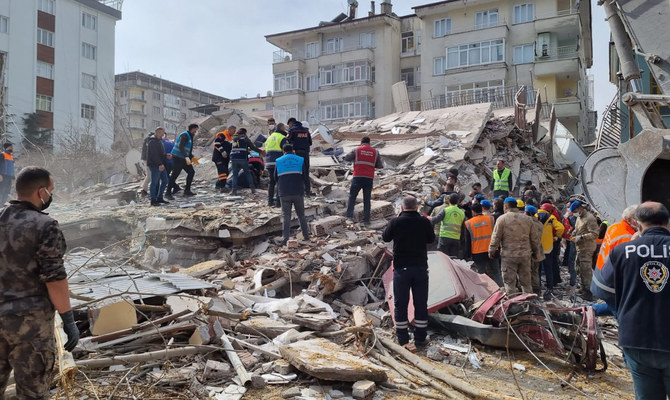Sara Al-Mulla
The world is today beset by natural hazards, many prompted by the climate crisis, which necessitates governments taking urgent actions toward becoming more agile and resilient. A study by the World Bank last year revealed the extent of the devastation spurred by natural disasters across the globe, estimating that, since 1980, more than 2.4 million lives have been lost, in addition to financial losses amounting to over $3.7 trillion, including an average of $167 billion a year in the last decade.
Designing robust disaster management strategies can amply reward all kinds of stakeholders. For societies, resilience ensures that human lives are prioritized and injuries are avoided. Upgrading and investing in climate-resistant structures can protect many important legacies, including community assets, critical facilities and cultural heritage sites. At the same time, cities will face fewer disruptions to essential services, such as education, healthcare and transportation. For enterprises, resilience will contribute to economic rewards, including better tax revenues, more business opportunities, higher economic growth, job creation and better-governed cities that attract more investment.
For governments to attain the maximum resilient stance when disasters occur, they must adopt a preparedness mindset rather than a reactive one, relying on optimizing response plans for various scenarios in order to make more thoughtful decisions. Concerning disasters, every minute is precious and acting swiftly and wisely can make a significant difference in both the short and long terms. Responding effectively to disasters can only come from building a competent and skilled workforce. Critically, this includes rescue teams, emergency health workers, fire brigades, counsellors, municipal service workers and engineers. Moreover, disasters have accelerated the need for research investment in the areas of alert systems, prevention, preparedness, risk management, response and recovery. Disaster risk assessments can identify specific vulnerabilities that various communities are exposed to and highlight the best plans for anticipation, mitigation and recovery.
Investment in state-of-the-art technology is a critical factor in accurately and swiftly responding to disasters. Modernizing information systems to collect live geographic data and create forecasts are an essential first step toward creating high-risk exposure maps. For instance, geospatial imaging technologies can track hurricanes and create sophisticated models that forecast a storm’s destructive force and evaluate different response scenarios. Mass alert systems can then trigger the necessary evacuations. Optimal disaster preparedness relies fundamentally on spearheading a coordinated response by the public, private and civil society sectors, harnessing the collective powers of all stakeholders to expedite recovery periods. As such, disaster management strategies must outline the roles and responsibilities of these various agents.
National government agencies must take responsibility for developing detailed charters that outline the roles and responsibilities of all national and local government agencies in the event of disasters. Furthermore, it is important for the national government to streamline the various programs under healthcare, welfare support, social services, shelter facilities and relief aid with sufficient funding, defined roles, clear accountability, approved policy charters and empowering legislation. Before the occurrence of a disaster, governments should shift to financing resilient infrastructure that can withstand the shocks associated with disasters, such as wind-resistant buildings, climate-proofing buildings against excessive heat, earthquake-resistant structures, sealed roof decks and floodable transport systems.
Success in responding to disasters depends greatly on having a clear communication matrix between various stakeholders, especially on media arrangements. In crises, it is imperative to promote desired behaviors and actions among communities through targeted education and awareness campaigns. Additionally, governments can promote preparedness online by sharing important advice on social media accounts and websites. Local government agencies can further coordinate on a micro level to deliver a suite of operational services directly to affected areas and communities. Leveraging solid community networks can enhance the delivery of disaster management resilience and recovery.
The recurrence of natural disasters led the US government to launch an effective national public service campaign called “Ready” in 2003, in order to be more forward-looking by empowering communities with practical knowledge and the skills to prepare for and respond to different kinds of emergencies. Its website has an abundance of comprehensive guidance on what to do in the event of hurricanes, flooding, wildfires, tornadoes, tsunamis and earthquakes. These include insuring one’s property and making it resilient to disasters, receiving alerts, safeguarding family documents, having a shelter plan, defining an evacuation route and creating a household communication plan. Moreover, households are encouraged to have ready emergency kits that include essential items, such as water, food, prescription medicines, infant formula, cash and family documents. Furthermore, special guidance should be published for enterprises to create practical business continuity plans, such as transitioning to e-commerce, automation or remote work solutions. Enterprises should also be encouraged to offer support, in the form of financial and in-kind donations.
Community groups can support victims of disasters by volunteering their time for rescue operations and donating important items, such as food and clothing. Educators can create awareness among students by incorporating preparedness skills within curricula. International organizations are pivotal in coordinating relief aid, in addition to providing technical cooperation, capacity development and resources. Nonprofit organizations can also train communities on basic disaster response skills, such as fire safety, disaster medical operations, first aid and rescue operations. The natural disaster landscape poses complex but not insurmountable challenges. However, it clearly illustrates the importance of designing robust disaster preparedness and response strategies well in advance.
Arab News







